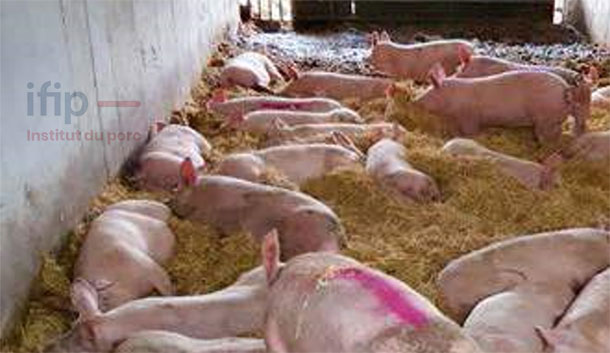The main molecules involved in these odor problems, known as boar taint are androstenone and skatole, which are deposited in adipose tissue. Androstenone is a hormone that originates in the testicles, the content of which can be reduced by genetic selection. Skatole is produced in the intestine and the main ways to reduce it are with the diet and keeping housing clean.
Among the risk factors for the presence of boar taint in the meat are the practice of raising own replacement animals and using heat-detection boars for reproduction. The males resulting from raising one's own replacements are often of maternal genetic lines, which are less conformed and, therefore, prone to the presence of boar taint. If the heat detection boars are allowed to mate, consider whether the heat detection boars are from the farm's own production or if they are siblings of the replacement sows. Some farmers use genetic types considered higher risk. In addition to genetic-related risk factors, in certain cases, animals are slaughtered at higher weights. The fasting period should be long enough (24 hours) to improve the cleanliness of the pigs and thus reduce the risk of odors.


The amount of straw added to the bedding has a significant effect on the occurrence of boar taint related to animal hygiene. This varies greatly from farm to farm and deserves particular attention in relation to the cleanliness of the animals. Fiber-rich raw materials are sometimes distributed at the end of the finishing period. This can be beneficial in reducing the rate of carcasses with boar taint.
Increasing the amount of straw distributed and incorporating alfalfa meal into the feed
The effect of increasing the amount of straw distributed in the pen to improve pig hygiene, combined with the incorporation of alfalfa meal in the feed given one month before slaughter to limit the production of intestinal skatole, was studied.
Two batches were compared. The first batch (control) was housed under normal conditions and fed the standard finishing diet, while the second batch (test) received 20% more straw during rearing, as well as additional straw before slaughter, and was fed a diet containing 10% alfalfa meal. The pigs were slaughtered, carcass characteristics were recorded, and backfat samples were taken to determine androstenone and skatole levels in this tissue.
The combination of adding additional straw and incorporating alfalfa meal into the feed was shown to be an interesting measure to reduce the deposition of skatole in the carcass fat of entire male pigs (Table 1).
Table 1. Carcass characteristics and skatole and androstenone content of back fat.
| Control | Test | |
|---|---|---|
| Carcass weight (kg) | 98.8 | 95.7 |
| Lean meat percentage in the main cuts (TMP, in French, %) | 59.2 | 59.8 |
| G2* (mm) | 15.7 | 14.8 |
| M2* (mm) | 58.7 | 58.3 |
| Skatole (μg/g liquid fat) | 0.14 | 0.06 |
| Androstenone (μg/g liquid fat) | 1.16 | 0.73 |
*G2 = the thickness of the fat (including rind), between the third and fourth last ribs, at 6 cm off the dorsal midline, at a trajectory parallel to this line (in millimetres), *M2 = the thickness of the muscle, between the third and fourth last ribs, at 6 cm off the dorsal midline, at a trajectory parallel to this line (in millimetres).
Pigs in the test batch had significantly lower levels of skatole and androstenone than pigs in the control batch. While the effect on skatole is explained by the massive addition of fiber to the feed and improved pig hygiene due to the addition of extra straw, the effect on androstenone is thought to be due to a delay in pubertal development following the distribution of less nutrient-dense feed.
This study shows the importance of animal hygiene in the frequency of the risk of boar taint in the meat of entire male animals. Incorporating fiber in the feed is also useful to achieve the same objective of reduction, although other fiber sources with a lower rate of incorporation can be used.
This study was carried out within the framework of the CASDAR Farinelli program, in collaboration with stakeholders in the organic swine industry (FNAB, ITAB, INRAE, Biodirect, Unebio, Lycée agricole du Rheu).



